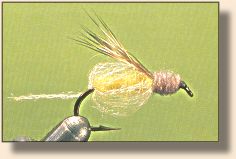
 Emergent Sparkle Pupa Skip Morris Photos by the Author
|
|
|
|
|
Tying Steps:
1. Start the thread at midshank. Separate two sections from a length
of four-section yarn. Comb the two sections with a fine-tooth comb.
(Tiny hooks will require only a single section.) Tie in the combed
yarn at midshank using the pinch. Trim the yarn's end.
 2. Pull the yarn back and hold down so that it slips around the shank. Hold the yarn under modest tension as you spiral the thread to the bend. The idea here is to distribute the fibers around the shank.
 3. Dub a substantial body up two-thirds of the shank.
 4. Cut the yarn so it is about two shanks in length. Hold the yarn back from the hook about one shank's length. Push the yarn straight at the rear of the shank to make the yarn fibers balloon out to the sides. You may have to try a couple of angles to get the fibers evenly distributed.
 5. Push the balloon straight at the shank and keep pushing until your finger and thumb travel to just in front of the eye and the fibers are taut and distributed around the body.
 6. Grasp the body, and the fibers, in the middle of the shank with the thumb and finger of your other hand. Slide your grasp again to just in front of the eye. Now the fibers are distributed evenly around the body and stroked to even tension.
 7. Still holding the fibers, push your grasp back to the front of the body which will again make the yarn fibers balloon. Now the veil is formed; you need only secure it. This is the time to tug out a few fibers with a scissor point to suggest part of the shuck, although some tiers don't bother with it.
 8. Add a few tight thread turns, and then trim the yarn. Comb and stack a bunch of deer hair. Use the reverse pinch to tie in the hair atop the hook. Trim the hair's butts and dub a short head over them. Complete the usual thread head. Trim the loose shuck fibers to about shank length, if there are any.

Fishing the Emergent Sparkle Pupa:For more great flies, check out: Beginning Fly Tying and Intermediate Fly Tying.
|
[ HOME ]
[ Search ] [ Contact FAOL ] [ Media Kit ]